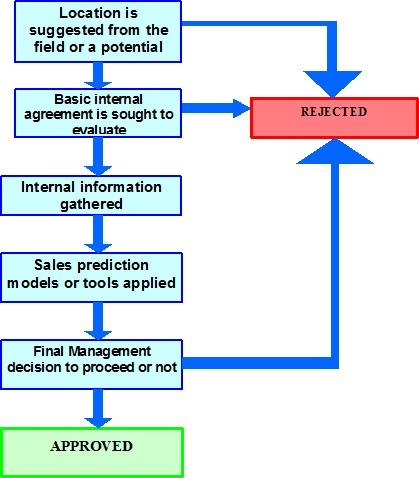In my past life as a Network Development Manager with Caltex, it became obvious to me that if you did not clearly explain what type of commercial property you were looking for, you wasted a great deal of your time looking at rubbish.
To try and filter the good location opportunities from the bad, I developed a two page Property Guideline, that I would happily send to all parties (commercial real estate agents, developers and land owners), who indicated they may have a potential site for us.
The Property Guideline was a mixture between information to help filter the sites, and yet not too much information that would give away our strategic thinking. Accompanying the Property Guideline was a quick Check Chart, and they were invited to read the Property Guideline, and if they still felt the site or block of land was of interest to us, fill in the quick Check Chart (similar to a Checklist) and send it back electronically.
The process was always done to try and work with genuinely interested commercial real estate agents, developers and land owners. If these people repeatedly ignored the Property Guideline and did not complete the Check Chart, it was a good indication that the site or land may not be worth looking at.
At Caltex, we would be offered several ‘opportunities’ a week. The oil industry works to some reasonably clear parameters, and it was just a matter of filtering real opportunities from time wasting ones.
Our Property Guideline use to address the following types of issues:
- Size – That we were looking for mid blocks of around 80 m long X 40 m wide approx. If a corner block, then around 60 m X 60 m
- Physical characteristics – our preference was a flat block, or if possible slightly above the road rather than below. We would prefer to be on a flat section or slightly uphill section of the road, definitely not a steep decline
- Side of road – we would prefer to be on the ‘going home’ outbound side of the road, or the ‘neutral’ direction. Inbound was not so good
- Competition – we obviously did not want to be on the same traffic flow as any of our other sites. Even better if few or no other competitors were servicing the area
- Road type – traffic flow was important, and the more, the better in general
- Visibility – we would want good visibility for our signage. The best was on the outside of a right hand curve in a road, so our signage was directly ahead of the traffic
- Access – you had to be able to come in and out easily. Not much good if you could not come in off the main road
- Demographics – in Australia probably the highest fuel users are medium income people, living in outer suburbs of the capital cities
- Suburbs or areas – we would nominate suburbs or specific areas we were actively seeking new sites in, and not be afraid to mention areas we were not looking at, either because we were well serviced in the area, or we knew the land cost would be prohibitive
Once this was all formed in the Property Guideline, it was willingly sent to all commercial real estate agents, developers and other interested parties we knew. The Check Chart allowed them to ‘tick the boxes’ and if they felt they had something along the lines of what we were seeking, we would then start to arrange meetings and open discussions.
In my years overseas with Caltex, we introduced this to most of the countries we visited.
In New Zealand, I had a real life example where the Property Manager had spent a day the previous week driving from Auckland to the Bay of Islands (four hours each way) to look at a block of land that was most unsuitable. He described it as a total waste of time. He said he wished I had been there the week before, as the Property Guideline and Check Chart would have eliminated the wasted trip and a day of his time.
The Property Guideline can assist the network development process in the first step in filtering the opportunity, before time is wasted on a full analysis. It is all about improving the quality of what is offered to you for consideration.
The Network Development Process as I see it as a flowchart.

Summary
 Loading…
Loading…
If you tell people what you are looking for, you have more chance of finding it. In my view, if you are unclear on what you want, you waste a great deal of your time looking at rubbish.
At Spectrum Analysis, we can help you develop your own Property Guideline and Site Potential Check Chart that is tailored to your needs.
Contact Spectrum Analysis if you would like more information or advice.

